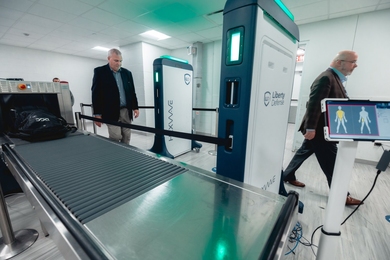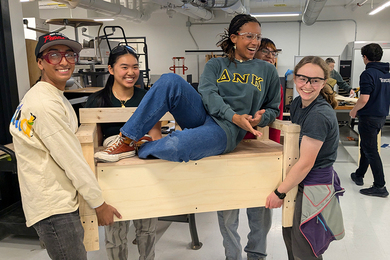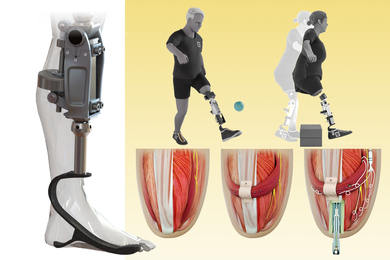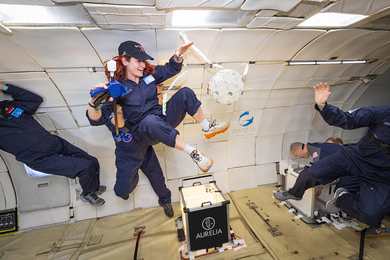Mucus hydrates and lubricates the eyes, the nose, the lungs, and the digestive and urogenital tracts, and prevents passage of harmful germs. But it also blocks drug delivery. One important question in biological hydrogel research is how to equip drug-delivery vehicles to pass through the protective mucus barrier.
Recent research by MIT postdoctoral associate Leon Li shows that ionic charges on molecules and the spatial arrangement of those charges each play a key role in transport through mucus.
The research was made possible by a microfluidic device, created by Li, that generates a tiny mucus barrier similar to those in the body. "Our microfluidic devices are designed to study animal and human mucus samples and experimentally mimic the geometry and physiology of the body's natural mucus barriers,” Li says. “We use these devices to perform detailed measurements of the interaction of molecules, viruses, and drug carriers with the mucus barriers. We also used these devices to study acid transport through mucus barriers. I realized that could be used to study protein transport and drug transport, so I adapted those devices."
The Laboratory for Biological Hydrogels now employs a suite of the microfluidic tools designed and fabricated by Li in collaboration with Professor Jongyoon Han's lab. The devices allow the researchers to reconstitute specific aspects of mucus transport that are much easier to measure outside the body.
Reconstituting mucus
To explore the selective filtration properties of the mucus barrier, Li used novel peptide-based molecular probes. Four groups of peptides were tested: positively charged peptides, negatively charged peptides, and peptides carrying a mix of negative and positive charges in two different arrangements.
"The mucus interacts with the peptides in very specific ways, depending on what peptide it is and how the charge is distributed on that peptide," Li says. By using isomers — peptides composed of the same atoms but with different spatial arrangements of their atoms and charges — Li and colleagues showed that the spatial arrangements of ionic charge can affect transport.
They published their findings in the Biophysical Journal paper "Spatial configuration and composition of charge modulates transport into a mucin hydrogel barrier." The paper's authors included Ribbeck, Professor Jongyoon Han of electrical engineering and computer science, MIT postdoc associate Thomas Crouzier, electrical engineering graduate student Aniruddh Sarkar, and biological engineering graduate student Laura Dunphy.
Nanoscale changes
The configurational differences among peptides occur at a very small scale, on the order of nanometers, Li says. The peptides he studied are about 10 nanometers long. "When you make arrangement changes on the order of nanometers, you can modulate the transport behavior of molecules inside of mucus," he says.
Drug carriers have typically been classified as either positively, negatively, or neutrally charged and as either adhesive or non-interactive. But Li's research suggests a new set of possibilities, based on nature itself, to use spatial configurations on a very small scale as selectivity criteria for transport across mucus barriers. "We are showing, in a sense, an additional finely tuned lever that lets us optimize how we send drugs across mucus barriers," Li says.
The findings suggest that drug and gene carriers could be designed with specific surface-charge configurations to optimize interactions with mucins in mucus for diseases such as cystic fibrosis and gastric ulcers.
The research also opens the possibility of engineering materials that could improve mucus barrier function. Strengthening the mucus barrier against chemical and biological agents might also be used for defense applications. The work did not consider hydrophobicity, another line of inquiry for future work.
Recent research by MIT postdoctoral associate Leon Li shows that ionic charges on molecules and the spatial arrangement of those charges each play a key role in transport through mucus.
The research was made possible by a microfluidic device, created by Li, that generates a tiny mucus barrier similar to those in the body. "Our microfluidic devices are designed to study animal and human mucus samples and experimentally mimic the geometry and physiology of the body's natural mucus barriers,” Li says. “We use these devices to perform detailed measurements of the interaction of molecules, viruses, and drug carriers with the mucus barriers. We also used these devices to study acid transport through mucus barriers. I realized that could be used to study protein transport and drug transport, so I adapted those devices."
The Laboratory for Biological Hydrogels now employs a suite of the microfluidic tools designed and fabricated by Li in collaboration with Professor Jongyoon Han's lab. The devices allow the researchers to reconstitute specific aspects of mucus transport that are much easier to measure outside the body.
Reconstituting mucus
To explore the selective filtration properties of the mucus barrier, Li used novel peptide-based molecular probes. Four groups of peptides were tested: positively charged peptides, negatively charged peptides, and peptides carrying a mix of negative and positive charges in two different arrangements.
"The mucus interacts with the peptides in very specific ways, depending on what peptide it is and how the charge is distributed on that peptide," Li says. By using isomers — peptides composed of the same atoms but with different spatial arrangements of their atoms and charges — Li and colleagues showed that the spatial arrangements of ionic charge can affect transport.
They published their findings in the Biophysical Journal paper "Spatial configuration and composition of charge modulates transport into a mucin hydrogel barrier." The paper's authors included Ribbeck, Professor Jongyoon Han of electrical engineering and computer science, MIT postdoc associate Thomas Crouzier, electrical engineering graduate student Aniruddh Sarkar, and biological engineering graduate student Laura Dunphy.
Nanoscale changes
The configurational differences among peptides occur at a very small scale, on the order of nanometers, Li says. The peptides he studied are about 10 nanometers long. "When you make arrangement changes on the order of nanometers, you can modulate the transport behavior of molecules inside of mucus," he says.
Drug carriers have typically been classified as either positively, negatively, or neutrally charged and as either adhesive or non-interactive. But Li's research suggests a new set of possibilities, based on nature itself, to use spatial configurations on a very small scale as selectivity criteria for transport across mucus barriers. "We are showing, in a sense, an additional finely tuned lever that lets us optimize how we send drugs across mucus barriers," Li says.
The findings suggest that drug and gene carriers could be designed with specific surface-charge configurations to optimize interactions with mucins in mucus for diseases such as cystic fibrosis and gastric ulcers.
The research also opens the possibility of engineering materials that could improve mucus barrier function. Strengthening the mucus barrier against chemical and biological agents might also be used for defense applications. The work did not consider hydrophobicity, another line of inquiry for future work.








